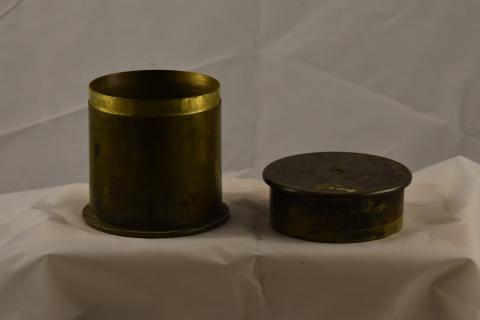This is a piece of trench art that was crafted by an unknown person during the First World War. The entirety of the piece is in two separate parts, both made out of spent 7.7cm "feldkanone 96" artillery shell casings. The larger of the pieces measures 8.9cm in height, while the smaller of the pieces measures 3.2cm in height. Both are of brass construction and have been altered by their original artisan to serve the role of a small container or storage vessel. During the First World War period, trench art became a very common form of artistic expression for not only those who endured the horrors of trench warfare, but also for artists experiencing the war second-hand. Trench art pieces were often used for a variety of purposes, such as tobacco containers, water vessels, ash trays, or even lighters. This content can be used with the following resources: SS-WH.9-12.26: Iowans Influence World History SS.3.28: Cultural Contributions This content can be used to educate students on the artistic contributions that were made by Iowa artists during the First World War, particularly in representation of the war itself and its various aspects. Pieces of trench art were common among all great powers that participated in the conflict, as it was a form of artistic and cultural expression that symbolized the experiences of those who lived through it. Over time, pieces of trench art have made their way to the Midwest and to Iowa, where they represent the contributions that Iowa made in the war and in the cultural arts during the first half of the twentieth century. For any use other than instructional resources, please check with the organization that owns this item for any copyright restrictions.
2018.002.033 [Artwork]
Legal Status
Copyright to this resource is held by the Iowa Masonic Library and Museum and has been provided here for educational purposes only, specifically for use in the Iowa Museum Association's "Teaching Iowa History" project. It may not be downloaded, reproduced or distributed in any format without written permission from the Rights Holder. For more information on U.S. and International copyright laws, consult an attorney.

